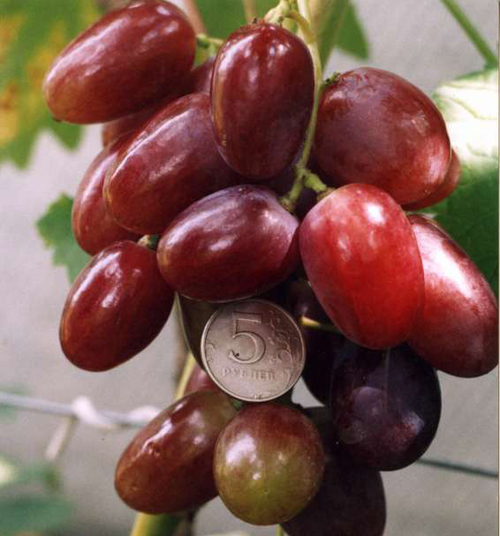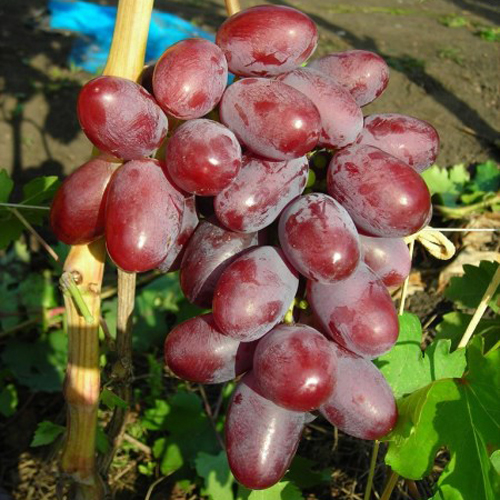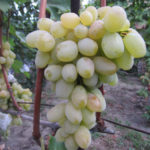Favor grape variety
The hybrid form of table dark-colored grapes called Favor is one of the many varieties of "sunny berries" born by the works of the famous national master of national selection Viktor Krainov. An amateur winegrower with extensive experience, in the last decades of his life, on the advice of the famous scientist from the All-Russian Research Institute of Viticulture and Winemaking Ivan Kostrikin, he began crossing various varieties and then selecting the most promising and attractive forms among the hybrid offspring.

Viktor Nikolayevich's creative activity captivated him so much that he managed to enrich the ampelographic diversity with several dozen of his brainchildren, many of which were so successful that they earned the right to be called varieties and were included in the state register of breeding achievements of the Russian Federation. Other varieties of it, although they did not receive such an honorable official recognition, however, at the amateur level, spread among a huge number of winegrowers, both in our country and abroad. It is to the second group that our hero can be attributed, obtained in the mid-2000s as a result of crossing very famous and high-quality grape varieties Mascot and Radiant kishmish... At first, the novelty with the big name Favor was coolly received by the sophisticated audience, but every year interest in it has invariably grown, and today the army of its fans has reached a very impressive size.
The growers who cultivate the hybrid on their plots are very impressed by its large-fruited, stunning appearance, high yield and good taste. In addition, it pleases its owners with good resistance to fungal diseases and comparative unpretentiousness in cultivation. But our hero has very few frank flaws. With a big stretch, they can be attributed to the not too early ripening period of the crop, which is sensitive only for farmers cultivating grapes for sale. Well, cracking of berries in case of heavy rains also cannot be called its strong point.
In general, in terms of the totality of characteristics, the variety can be considered quite successful, and it can be recommended for planting wherever climatic conditions allow a ripe crop to be obtained.

Agrobiological characteristics
The bushes are distinguished by their large size and active growth of young shoots. The leaves are formed by large, rounded, dark green, consisting of three or five lobes, and a fairly strong dissection between them. The profile of the leaf blade is flat or slightly wavy. Sometimes the edges of the blades are bent downward. The surface of the leaf is reticulate and wrinkled. The upper side notches are deep, most often closed with an ovoid lumen, or open in the form of a lyre with a rounded bottom. The lower notches are smaller, but often their appearance overlaps with the upper ones. The petiole notches are almost always open, broadly vaulted, with a flat and pointed bottom. The petioles do not greatly exceed the length of the main vein of the leaf, they are colored greenish-red. The denticles along the perimeter of grape leaves are medium in height. Their bases are wide, the edges are convex, and the tops are pointed. The flowers are bisexual, requiring no nearby pollinator varieties. Peeling berries is not typical at all. As a rule, there are no problems with the maturation of a one-year growth.
Magnificent clusters are the main decoration of Favor.Their typical mass reaches values of 600-1000 grams, the shape is conical, the structure is medium-dense. The evenness of large grapes adds a special elegance to the brushes, moreover, they do not deform in bunches, due to not too strong contact with each other. The combs grow long and strong, herbaceous, colored, like the leaf stalks, in reddish shades. The berries are very large, elongated-oval, about 30-31 mm long, and 24-25 mm in diameter. The mass of one such grape is 12-15 grams, and the most outstanding ones can weigh up to 20 grams. The color of ripe fruits is red-violet, on their surface there is an intense gray protective waxy coating. The flesh of the berry is moderately dense, juicy-fleshy, very harmonious in taste with a pleasant varietal aroma. Sugar accumulation is high - 19-21 g / 100 ml of juice, moderate titratable acidity - 5-6 g / l. The peel of the fruit is strong enough, but edible. The presence of seeds, no more than 2-3, does not particularly reduce the excellent gastronomic characteristics of the grapes.
The bulk of the crop is used for fresh consumption. The variety, due to its aesthetic appeal, enjoys undoubted success with buyers, and, moreover, does not lose its presentation as a result of transportation over long distances. However, farmers plant Tabor on their plots less willingly than early maturing varieties and hybrids, because the moment of ripening of the crop falls on him during the period of the most active competition and low prices on the market. In the conditions of the Lower Don region, for example, this is the first or second decade of September. The way out here can be the laying of this grape for long-term storage, which, according to reviews, it tolerates well.
The rather long growing season for our hero, which is about 130-135 days with a sum of active temperatures of 2700-2800 ° C, does not allow cultivating it in open ground north of the Central Black Earth zone. In frost-prone regions, in addition, sufficient attention should be paid to the insulation of the above-ground part of the bushes for the winter, because the uncovered Tabor vine gets severe damage already at -23 ° С.
The productivity of grape bushes is high and stable over the years. It is due, in addition to the large-fruited variety, good fertility and a fruiting coefficient - on average, about 1.3 bunches per shoot. This indicator allows you to form a decent harvest even if some of the eyes die from low temperatures, however, after warm winters, the load may be excessive, and plants will need to limit it. Usually, the bushes are cut in the spring by 30-35 eyes, leaving 7 to 10 buds on the fruit arrows.
Tabor has medium resistance to powdery mildew and gray rot, and increased resistance to mildew, due to which its cultivation can take place with a gentle pesticide load. But after ripening, the grapes should not be left on the bushes for a long time due to the risk of cracking the berries as a result of prolonged autumn rains.








